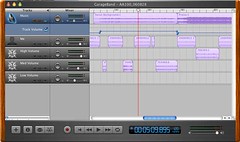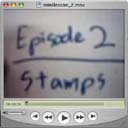Warning: The following podcast contains words which, when placed in a particular order, can be used to convey ideas. People who are set in their ways should listen at their own discretion.
 So this weekend I actually got caught up on my audio podcasts. This was no small achievement, as I had several gigabytes of downloaded but unplayed podcasts on my hard drive before I went to the DEN National Institute, and while there I didn’t really listen to any of them until after I got back home.
So this weekend I actually got caught up on my audio podcasts. This was no small achievement, as I had several gigabytes of downloaded but unplayed podcasts on my hard drive before I went to the DEN National Institute, and while there I didn’t really listen to any of them until after I got back home.
That being said, I still have 43 video podcasts waiting for me to watch them. There was a time when video podcasting was unheard of, due to a combination of bandwidth, storage, and equipment costs. Times have changed since then, and while audio podcasts still outnumber their video cousins, there seem to be a lot more .mp4 files showing up in my podcatcher these days.
Unfortunately for me, my method of experiencing these podcasts hasn’t changed much at all. I mostly play them when I’m in the car, playing video games, doing dishes, researching art lessons, folding laundry, and playing video games – you know, activities where my eyes are required to be actively engaged in something other than watching video. It’s this ability to multi-task that drew me in part to podcasting in the first place.
But with video – good video – your attention is demanded. You might still be able to multi-task, but as you can’t look at two things as well as one you’ll always be missing something.
And that’s my inspiration for this episode – a comparison of the pros and cons of video and audio formats.
Cost
 Audio podcasts have a much lower entry cost, both for creating them and carrying them on portable devices. I can spend $50 or less and get a half decent mp3 player, but it won’t do video at that price. Add to that the fact that all I need is a phone to record an episode and I don’t even need a computer with a working microphone to get started.
Audio podcasts have a much lower entry cost, both for creating them and carrying them on portable devices. I can spend $50 or less and get a half decent mp3 player, but it won’t do video at that price. Add to that the fact that all I need is a phone to record an episode and I don’t even need a computer with a working microphone to get started.
Video podcasts have gotten cheaper over the years (due in no small part to the iPod’s video capabilities and competitors’ desire to give more value for a lower price), with portable video players selling for $100 or less. Recording equipment is coming down in price too, with decent digital video cameras selling for $200 or less. Digital still cameras are actually able to record half decent video nowadays, and let’s face it, lots of laptops have built in cameras so you might not even have to buy anything new at all.
Work Load
Audio is, in my opinion, easier to edit than video. A lot easier. I can very easily remove hums, haws, ers, ums, yawns, and so on without the listener ever knowing those things were in there, provided there are no visual cues. When I cut something out of video using the same process, you notice. Yes, there are ways to cover these things up, but they’re not as simple to do as the tried and true “select, delete, and move on” method of editing audio.
Of course I suppose you could always go with the “I don’t edit my podcasts” method that some people have adopted, but I’m not willing to go there … yet.
Multi-Tasking
I’ve already covered this a little bit. When recording or listening to audio, it’s very easy to be doing something else at the same time. With video this is only possible if you don’t care much for at least one of the things that’s demanding your attention, and I for one don’t want to put the extra work into a video podcast if no one’s going to watch it.
Wow, I’m really hammering the video format in this episode, aren’t I? With all of these drawbacks, is there any reason to choose video over audio? You bet there is!
Multiple Learning Styles
 Using an audio only format appeals the most to people who learn that way, but some of us (myself included) are visual thinkers. We can still digest information by hearing it, but it’s so much easier if you show us as well.
Using an audio only format appeals the most to people who learn that way, but some of us (myself included) are visual thinkers. We can still digest information by hearing it, but it’s so much easier if you show us as well.
And by “show,” I mean it. Talking heads add very little to a presentation, but you can still insert slides from a PowerPoint, images of examples, and the like to keep your viewer’s interests. It’s true that many of the video podcasts I’ve made myself had that very problem (even if the times I waxed theatric helped a little bit), but I eventually came to realize that my audience wasn’t getting much more out of it through the video I was including.
That’s why I’m back to audio only for the most part, saving video for special occasions. I think the only reason I got away with what I was doing was because video podcasts were still somewhat new at the time, and the “wow, this is new!” factor gave me a bit of an edge.
The problem is, newness doesn’t last.
Now there are people out there that are doing it right. If you ever get a chance to see one of Lawrence Lessig’s presentations you’ll see what I mean. They’re simple, true, but every slide reinforces the message he’s trying to convey.
A recent presentation on the culture of YouTube (found via Will Richardson) would make another excellent, if a bit long, video podcast. There’s a lot of talking heads in it, but the scenes are varied, mixed with images and video from a variety of sources, and even the inserted still images move across the screen in a way to support his message.





